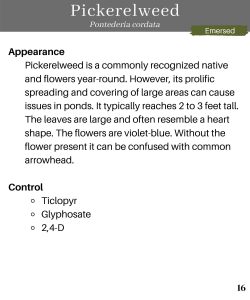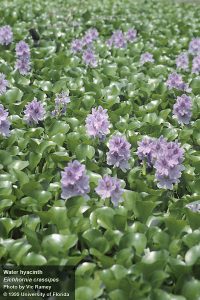I often get calls on how to control pickerelweed. Although this beautiful aquatic plant is a Florida native, it can spread prolifically leaving pond owners with the assumption that it’s an invasive weed. Invasive plants are non-native species that are characterized as difficult to control, having multiple reproductive methods, rapid spread, and responsible for the degradation of entire ecosystems. Pickerelweed is a pollinator friendly plant that thrives in its native habitat, Florida.



Water hyacinth looks similar to pickerelweed, with its purple blossoms and round, fleshy leaves. However, unlike our friend pickerelweed, water hyacinth is an invasive species. Originally from South America, it was introduced to the U.S.in 1884 as an ornamental. It reproduces prolifically by producing stolons and forms mats that can double in size in just 6-18 days.
Planting pickerelweed can help stabilize pond banks and add pond appeal. Planting it containers without drainage holes in 4 feet spacing can help minimize spreading to the whole pond. For more information on these species or help identifying plants in your pond, contact your local county extension agent.
 0
0
